Analysis of Cloud Computing and Mainframe Usage in Banking (ITECH1104)
VerifiedAdded on 2022/09/18
|9
|1854
|41
Report
AI Summary
This report delves into the application of cloud computing within the banking sector, examining its benefits and integration with existing mainframe technologies. The introduction highlights the growing adoption of cloud services by financial institutions, emphasizing cost savings, business agility, and enhanced security. The report then explores core banking services, including individual, business, and digital banking, along with the security measures necessary to protect sensitive financial data. It outlines the ICT workload types in banking, the benefits of cloud technologies (such as improved manageability and data security), and the reasons major banks still rely on mainframes. The analysis underscores the importance of a defense-in-depth security strategy and encryption for data protection. The conclusion summarizes the advantages of cloud computing in banking, emphasizing its role in cost reduction, business continuity, and efficient data management. The report is supported by references to academic and industry sources.
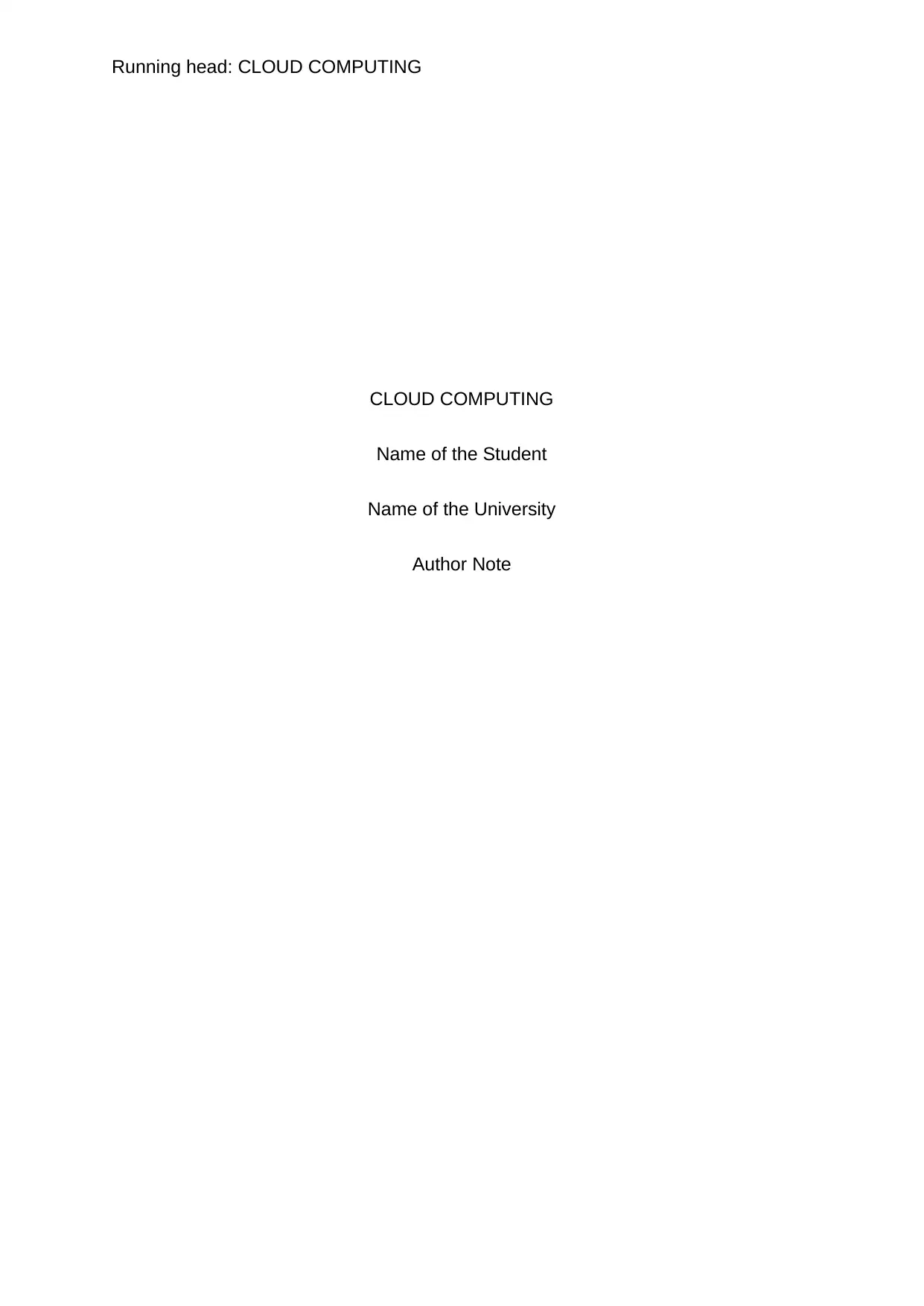
Running head: CLOUD COMPUTING
CLOUD COMPUTING
Name of the Student
Name of the University
Author Note
CLOUD COMPUTING
Name of the Student
Name of the University
Author Note
Paraphrase This Document
Need a fresh take? Get an instant paraphrase of this document with our AI Paraphraser
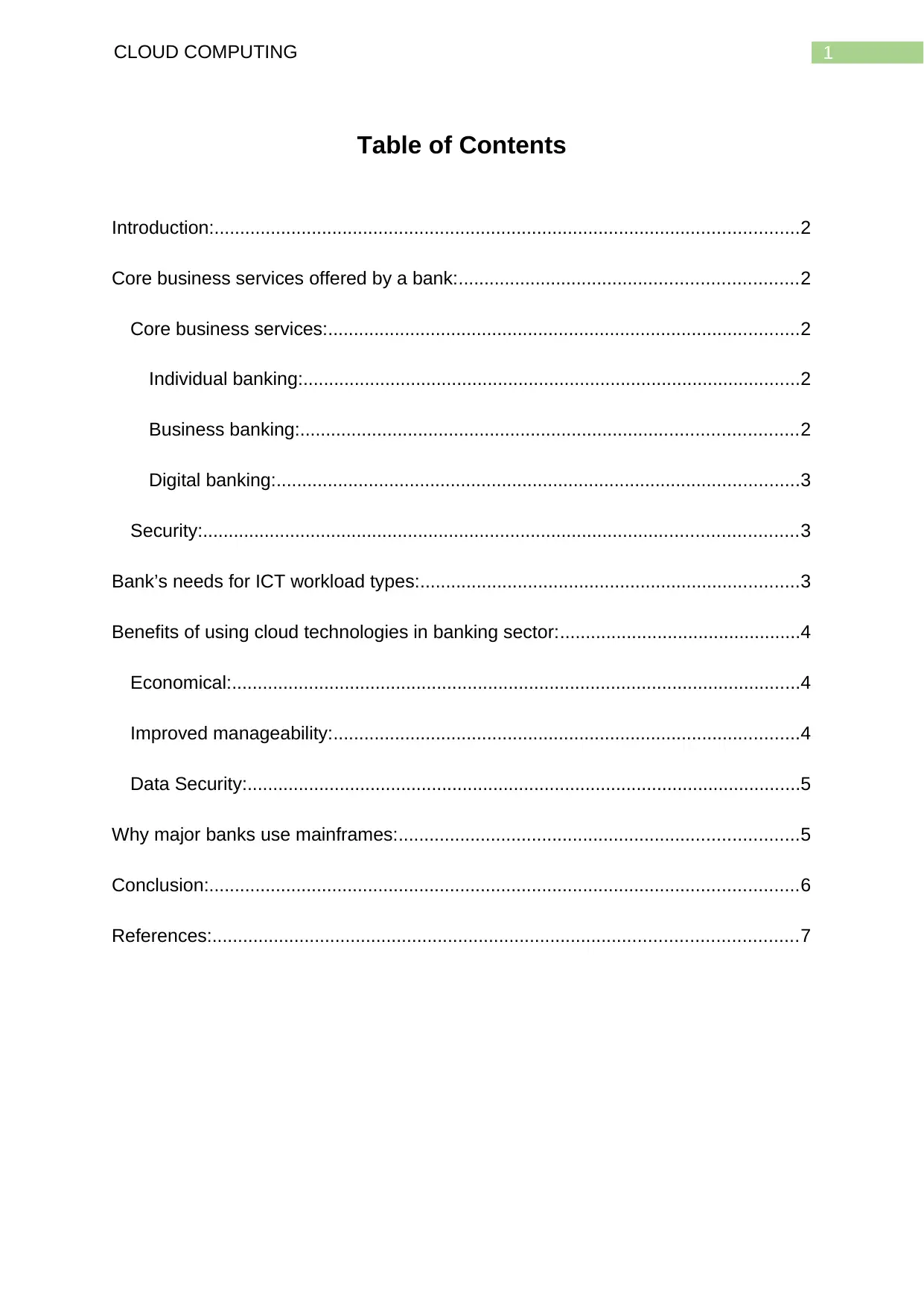
CLOUD COMPUTING 1
Table of Contents
Introduction:..................................................................................................................2
Core business services offered by a bank:..................................................................2
Core business services:............................................................................................2
Individual banking:.................................................................................................2
Business banking:.................................................................................................2
Digital banking:......................................................................................................3
Security:....................................................................................................................3
Bank’s needs for ICT workload types:..........................................................................3
Benefits of using cloud technologies in banking sector:...............................................4
Economical:...............................................................................................................4
Improved manageability:...........................................................................................4
Data Security:............................................................................................................5
Why major banks use mainframes:..............................................................................5
Conclusion:...................................................................................................................6
References:..................................................................................................................7
Table of Contents
Introduction:..................................................................................................................2
Core business services offered by a bank:..................................................................2
Core business services:............................................................................................2
Individual banking:.................................................................................................2
Business banking:.................................................................................................2
Digital banking:......................................................................................................3
Security:....................................................................................................................3
Bank’s needs for ICT workload types:..........................................................................3
Benefits of using cloud technologies in banking sector:...............................................4
Economical:...............................................................................................................4
Improved manageability:...........................................................................................4
Data Security:............................................................................................................5
Why major banks use mainframes:..............................................................................5
Conclusion:...................................................................................................................6
References:..................................................................................................................7
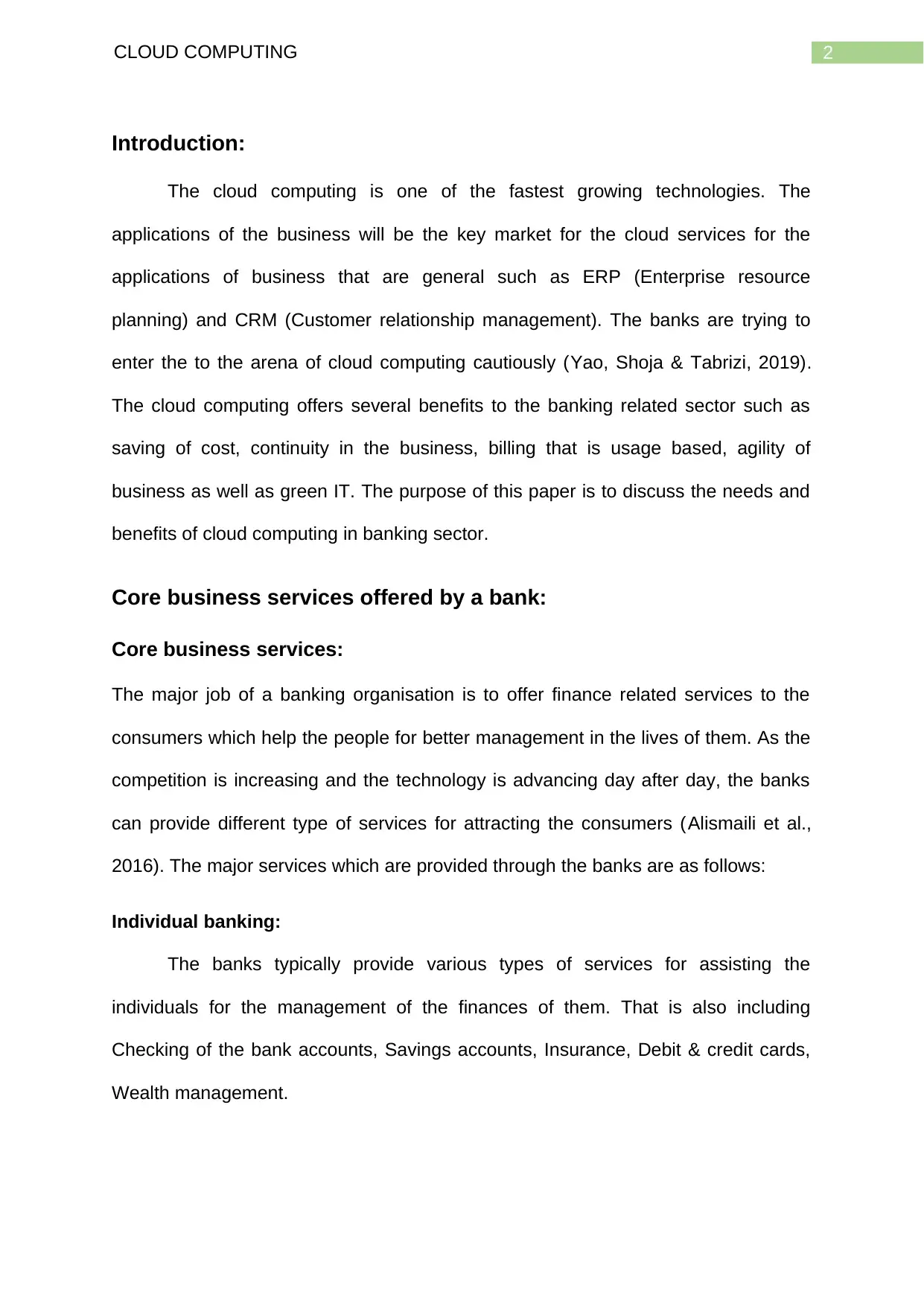
2CLOUD COMPUTING
Introduction:
The cloud computing is one of the fastest growing technologies. The
applications of the business will be the key market for the cloud services for the
applications of business that are general such as ERP (Enterprise resource
planning) and CRM (Customer relationship management). The banks are trying to
enter the to the arena of cloud computing cautiously (Yao, Shoja & Tabrizi, 2019).
The cloud computing offers several benefits to the banking related sector such as
saving of cost, continuity in the business, billing that is usage based, agility of
business as well as green IT. The purpose of this paper is to discuss the needs and
benefits of cloud computing in banking sector.
Core business services offered by a bank:
Core business services:
The major job of a banking organisation is to offer finance related services to the
consumers which help the people for better management in the lives of them. As the
competition is increasing and the technology is advancing day after day, the banks
can provide different type of services for attracting the consumers (Alismaili et al.,
2016). The major services which are provided through the banks are as follows:
Individual banking:
The banks typically provide various types of services for assisting the
individuals for the management of the finances of them. That is also including
Checking of the bank accounts, Savings accounts, Insurance, Debit & credit cards,
Wealth management.
Introduction:
The cloud computing is one of the fastest growing technologies. The
applications of the business will be the key market for the cloud services for the
applications of business that are general such as ERP (Enterprise resource
planning) and CRM (Customer relationship management). The banks are trying to
enter the to the arena of cloud computing cautiously (Yao, Shoja & Tabrizi, 2019).
The cloud computing offers several benefits to the banking related sector such as
saving of cost, continuity in the business, billing that is usage based, agility of
business as well as green IT. The purpose of this paper is to discuss the needs and
benefits of cloud computing in banking sector.
Core business services offered by a bank:
Core business services:
The major job of a banking organisation is to offer finance related services to the
consumers which help the people for better management in the lives of them. As the
competition is increasing and the technology is advancing day after day, the banks
can provide different type of services for attracting the consumers (Alismaili et al.,
2016). The major services which are provided through the banks are as follows:
Individual banking:
The banks typically provide various types of services for assisting the
individuals for the management of the finances of them. That is also including
Checking of the bank accounts, Savings accounts, Insurance, Debit & credit cards,
Wealth management.
⊘ This is a preview!⊘
Do you want full access?
Subscribe today to unlock all pages.

Trusted by 1+ million students worldwide
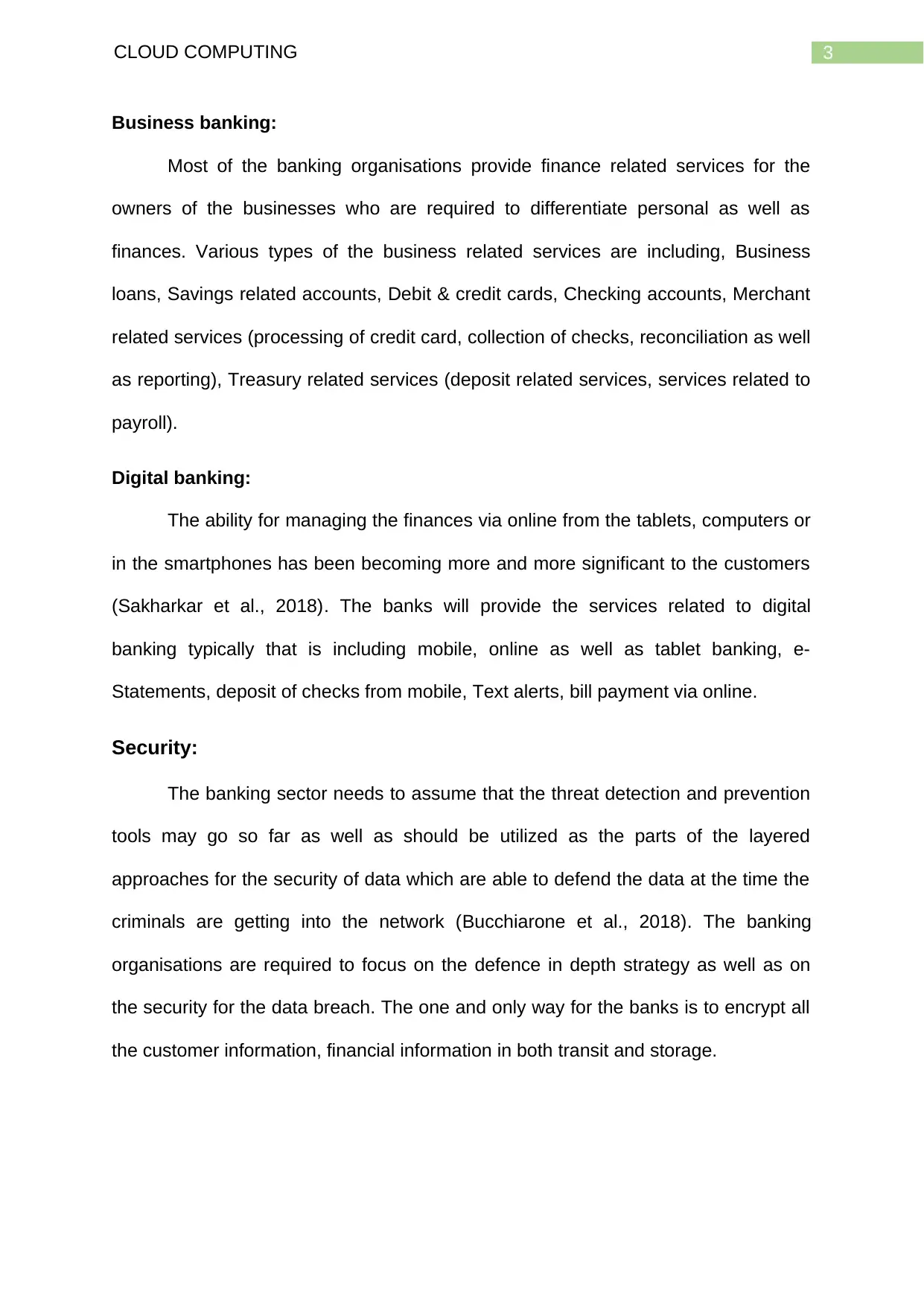
3CLOUD COMPUTING
Business banking:
Most of the banking organisations provide finance related services for the
owners of the businesses who are required to differentiate personal as well as
finances. Various types of the business related services are including, Business
loans, Savings related accounts, Debit & credit cards, Checking accounts, Merchant
related services (processing of credit card, collection of checks, reconciliation as well
as reporting), Treasury related services (deposit related services, services related to
payroll).
Digital banking:
The ability for managing the finances via online from the tablets, computers or
in the smartphones has been becoming more and more significant to the customers
(Sakharkar et al., 2018). The banks will provide the services related to digital
banking typically that is including mobile, online as well as tablet banking, e-
Statements, deposit of checks from mobile, Text alerts, bill payment via online.
Security:
The banking sector needs to assume that the threat detection and prevention
tools may go so far as well as should be utilized as the parts of the layered
approaches for the security of data which are able to defend the data at the time the
criminals are getting into the network (Bucchiarone et al., 2018). The banking
organisations are required to focus on the defence in depth strategy as well as on
the security for the data breach. The one and only way for the banks is to encrypt all
the customer information, financial information in both transit and storage.
Business banking:
Most of the banking organisations provide finance related services for the
owners of the businesses who are required to differentiate personal as well as
finances. Various types of the business related services are including, Business
loans, Savings related accounts, Debit & credit cards, Checking accounts, Merchant
related services (processing of credit card, collection of checks, reconciliation as well
as reporting), Treasury related services (deposit related services, services related to
payroll).
Digital banking:
The ability for managing the finances via online from the tablets, computers or
in the smartphones has been becoming more and more significant to the customers
(Sakharkar et al., 2018). The banks will provide the services related to digital
banking typically that is including mobile, online as well as tablet banking, e-
Statements, deposit of checks from mobile, Text alerts, bill payment via online.
Security:
The banking sector needs to assume that the threat detection and prevention
tools may go so far as well as should be utilized as the parts of the layered
approaches for the security of data which are able to defend the data at the time the
criminals are getting into the network (Bucchiarone et al., 2018). The banking
organisations are required to focus on the defence in depth strategy as well as on
the security for the data breach. The one and only way for the banks is to encrypt all
the customer information, financial information in both transit and storage.
Paraphrase This Document
Need a fresh take? Get an instant paraphrase of this document with our AI Paraphraser
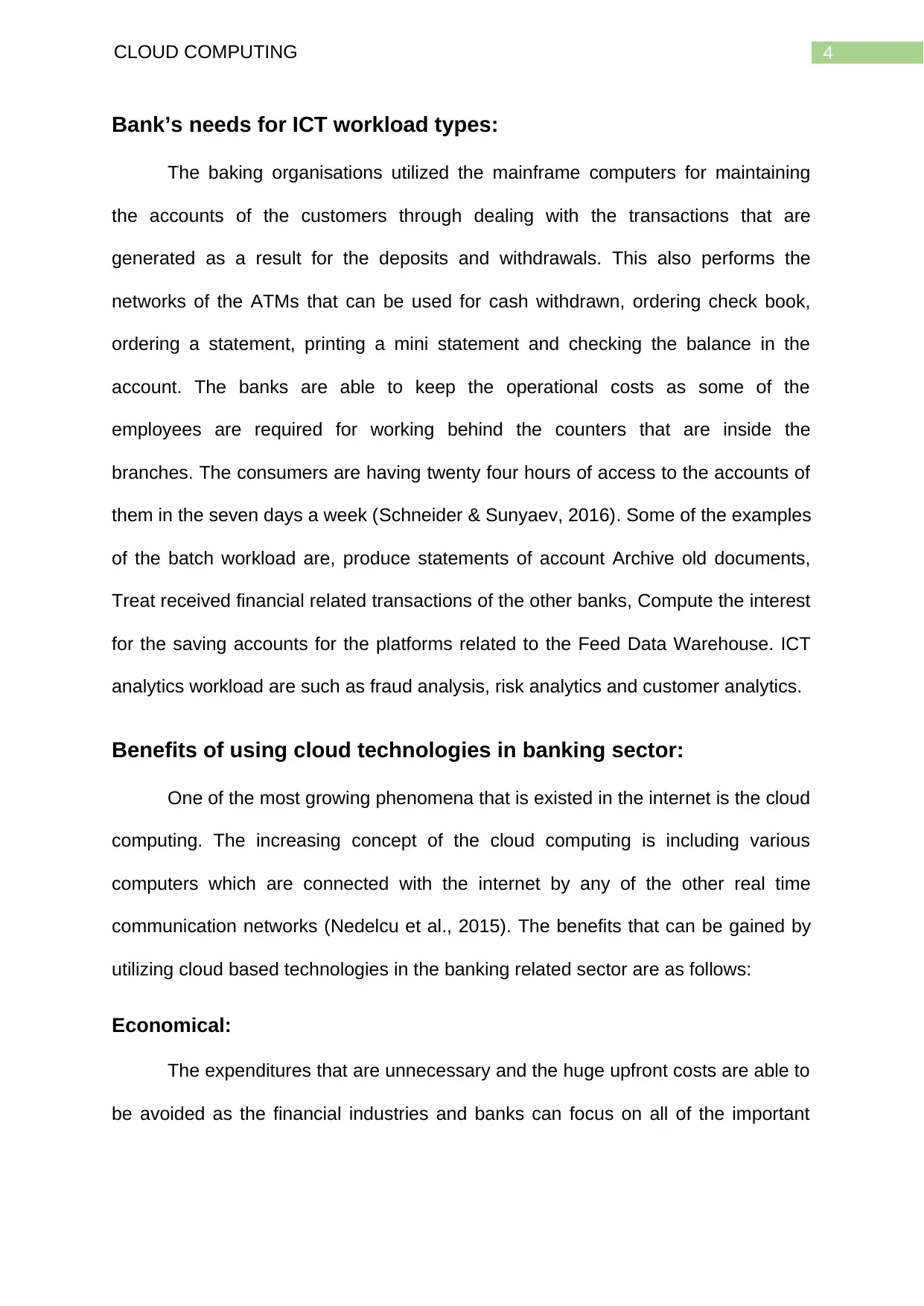
4CLOUD COMPUTING
Bank’s needs for ICT workload types:
The baking organisations utilized the mainframe computers for maintaining
the accounts of the customers through dealing with the transactions that are
generated as a result for the deposits and withdrawals. This also performs the
networks of the ATMs that can be used for cash withdrawn, ordering check book,
ordering a statement, printing a mini statement and checking the balance in the
account. The banks are able to keep the operational costs as some of the
employees are required for working behind the counters that are inside the
branches. The consumers are having twenty four hours of access to the accounts of
them in the seven days a week (Schneider & Sunyaev, 2016). Some of the examples
of the batch workload are, produce statements of account Archive old documents,
Treat received financial related transactions of the other banks, Compute the interest
for the saving accounts for the platforms related to the Feed Data Warehouse. ICT
analytics workload are such as fraud analysis, risk analytics and customer analytics.
Benefits of using cloud technologies in banking sector:
One of the most growing phenomena that is existed in the internet is the cloud
computing. The increasing concept of the cloud computing is including various
computers which are connected with the internet by any of the other real time
communication networks (Nedelcu et al., 2015). The benefits that can be gained by
utilizing cloud based technologies in the banking related sector are as follows:
Economical:
The expenditures that are unnecessary and the huge upfront costs are able to
be avoided as the financial industries and banks can focus on all of the important
Bank’s needs for ICT workload types:
The baking organisations utilized the mainframe computers for maintaining
the accounts of the customers through dealing with the transactions that are
generated as a result for the deposits and withdrawals. This also performs the
networks of the ATMs that can be used for cash withdrawn, ordering check book,
ordering a statement, printing a mini statement and checking the balance in the
account. The banks are able to keep the operational costs as some of the
employees are required for working behind the counters that are inside the
branches. The consumers are having twenty four hours of access to the accounts of
them in the seven days a week (Schneider & Sunyaev, 2016). Some of the examples
of the batch workload are, produce statements of account Archive old documents,
Treat received financial related transactions of the other banks, Compute the interest
for the saving accounts for the platforms related to the Feed Data Warehouse. ICT
analytics workload are such as fraud analysis, risk analytics and customer analytics.
Benefits of using cloud technologies in banking sector:
One of the most growing phenomena that is existed in the internet is the cloud
computing. The increasing concept of the cloud computing is including various
computers which are connected with the internet by any of the other real time
communication networks (Nedelcu et al., 2015). The benefits that can be gained by
utilizing cloud based technologies in the banking related sector are as follows:
Economical:
The expenditures that are unnecessary and the huge upfront costs are able to
be avoided as the financial industries and banks can focus on all of the important
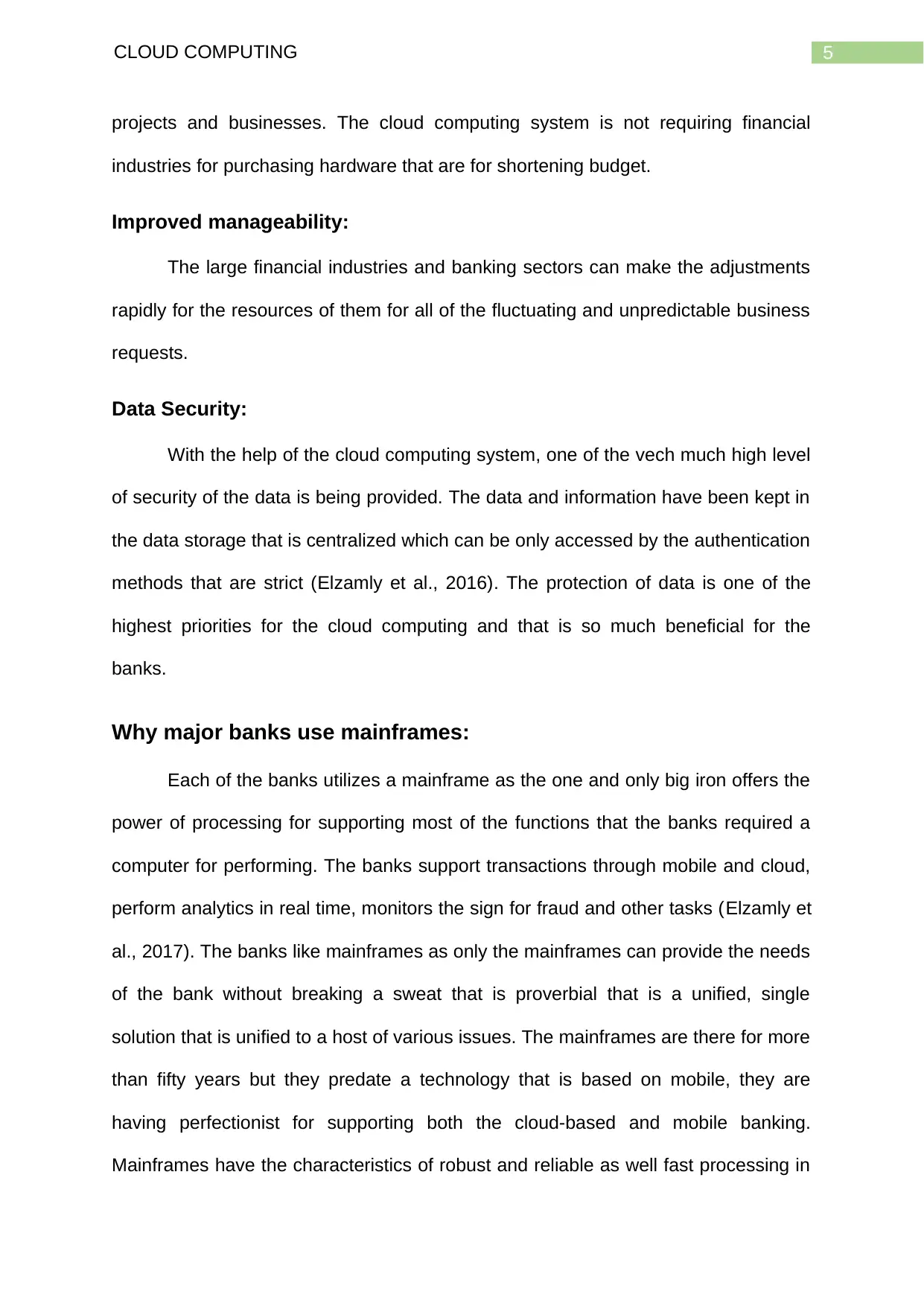
5CLOUD COMPUTING
projects and businesses. The cloud computing system is not requiring financial
industries for purchasing hardware that are for shortening budget.
Improved manageability:
The large financial industries and banking sectors can make the adjustments
rapidly for the resources of them for all of the fluctuating and unpredictable business
requests.
Data Security:
With the help of the cloud computing system, one of the vech much high level
of security of the data is being provided. The data and information have been kept in
the data storage that is centralized which can be only accessed by the authentication
methods that are strict (Elzamly et al., 2016). The protection of data is one of the
highest priorities for the cloud computing and that is so much beneficial for the
banks.
Why major banks use mainframes:
Each of the banks utilizes a mainframe as the one and only big iron offers the
power of processing for supporting most of the functions that the banks required a
computer for performing. The banks support transactions through mobile and cloud,
perform analytics in real time, monitors the sign for fraud and other tasks (Elzamly et
al., 2017). The banks like mainframes as only the mainframes can provide the needs
of the bank without breaking a sweat that is proverbial that is a unified, single
solution that is unified to a host of various issues. The mainframes are there for more
than fifty years but they predate a technology that is based on mobile, they are
having perfectionist for supporting both the cloud-based and mobile banking.
Mainframes have the characteristics of robust and reliable as well fast processing in
projects and businesses. The cloud computing system is not requiring financial
industries for purchasing hardware that are for shortening budget.
Improved manageability:
The large financial industries and banking sectors can make the adjustments
rapidly for the resources of them for all of the fluctuating and unpredictable business
requests.
Data Security:
With the help of the cloud computing system, one of the vech much high level
of security of the data is being provided. The data and information have been kept in
the data storage that is centralized which can be only accessed by the authentication
methods that are strict (Elzamly et al., 2016). The protection of data is one of the
highest priorities for the cloud computing and that is so much beneficial for the
banks.
Why major banks use mainframes:
Each of the banks utilizes a mainframe as the one and only big iron offers the
power of processing for supporting most of the functions that the banks required a
computer for performing. The banks support transactions through mobile and cloud,
perform analytics in real time, monitors the sign for fraud and other tasks (Elzamly et
al., 2017). The banks like mainframes as only the mainframes can provide the needs
of the bank without breaking a sweat that is proverbial that is a unified, single
solution that is unified to a host of various issues. The mainframes are there for more
than fifty years but they predate a technology that is based on mobile, they are
having perfectionist for supporting both the cloud-based and mobile banking.
Mainframes have the characteristics of robust and reliable as well fast processing in
⊘ This is a preview!⊘
Do you want full access?
Subscribe today to unlock all pages.

Trusted by 1+ million students worldwide
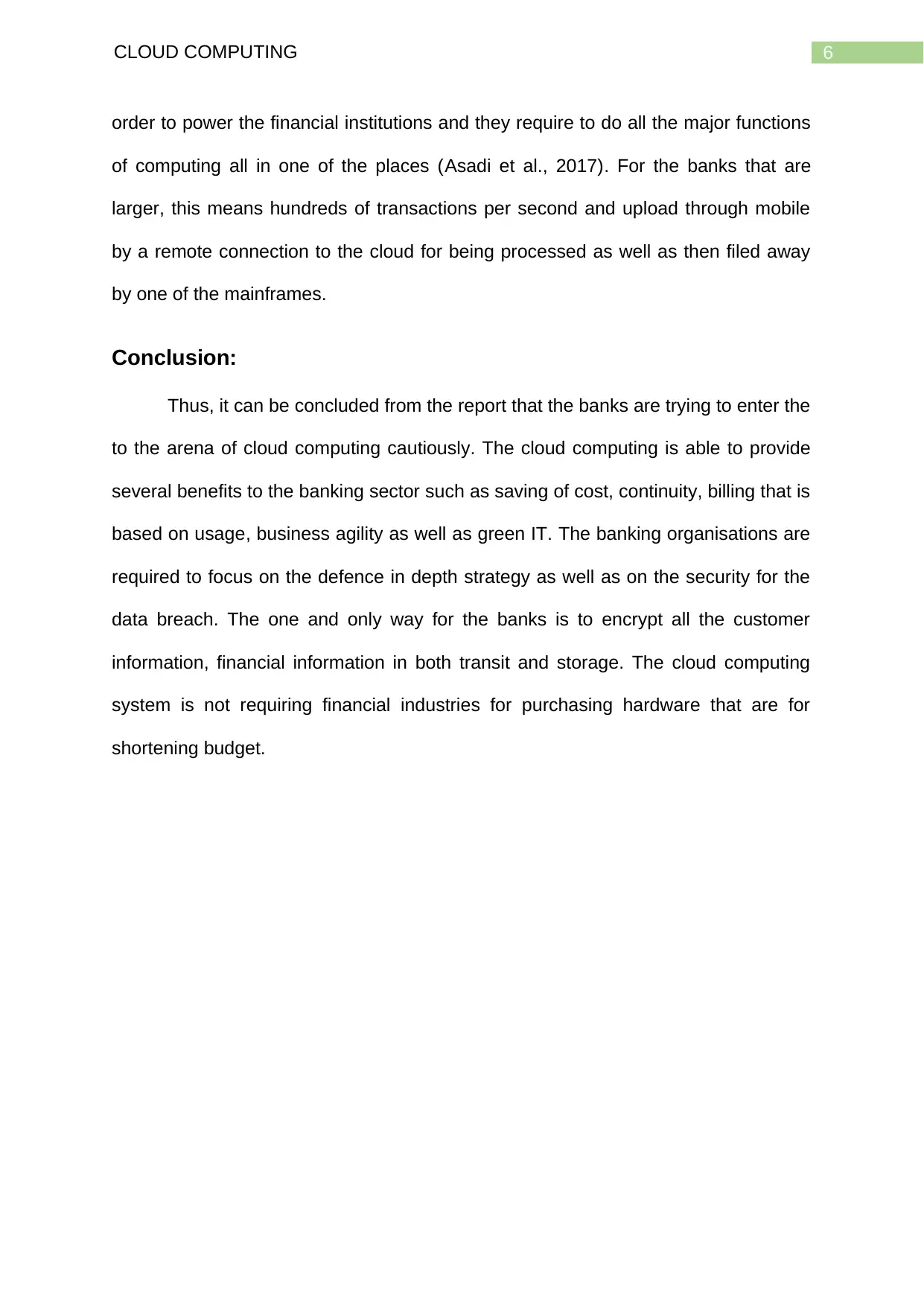
6CLOUD COMPUTING
order to power the financial institutions and they require to do all the major functions
of computing all in one of the places (Asadi et al., 2017). For the banks that are
larger, this means hundreds of transactions per second and upload through mobile
by a remote connection to the cloud for being processed as well as then filed away
by one of the mainframes.
Conclusion:
Thus, it can be concluded from the report that the banks are trying to enter the
to the arena of cloud computing cautiously. The cloud computing is able to provide
several benefits to the banking sector such as saving of cost, continuity, billing that is
based on usage, business agility as well as green IT. The banking organisations are
required to focus on the defence in depth strategy as well as on the security for the
data breach. The one and only way for the banks is to encrypt all the customer
information, financial information in both transit and storage. The cloud computing
system is not requiring financial industries for purchasing hardware that are for
shortening budget.
order to power the financial institutions and they require to do all the major functions
of computing all in one of the places (Asadi et al., 2017). For the banks that are
larger, this means hundreds of transactions per second and upload through mobile
by a remote connection to the cloud for being processed as well as then filed away
by one of the mainframes.
Conclusion:
Thus, it can be concluded from the report that the banks are trying to enter the
to the arena of cloud computing cautiously. The cloud computing is able to provide
several benefits to the banking sector such as saving of cost, continuity, billing that is
based on usage, business agility as well as green IT. The banking organisations are
required to focus on the defence in depth strategy as well as on the security for the
data breach. The one and only way for the banks is to encrypt all the customer
information, financial information in both transit and storage. The cloud computing
system is not requiring financial industries for purchasing hardware that are for
shortening budget.
Paraphrase This Document
Need a fresh take? Get an instant paraphrase of this document with our AI Paraphraser
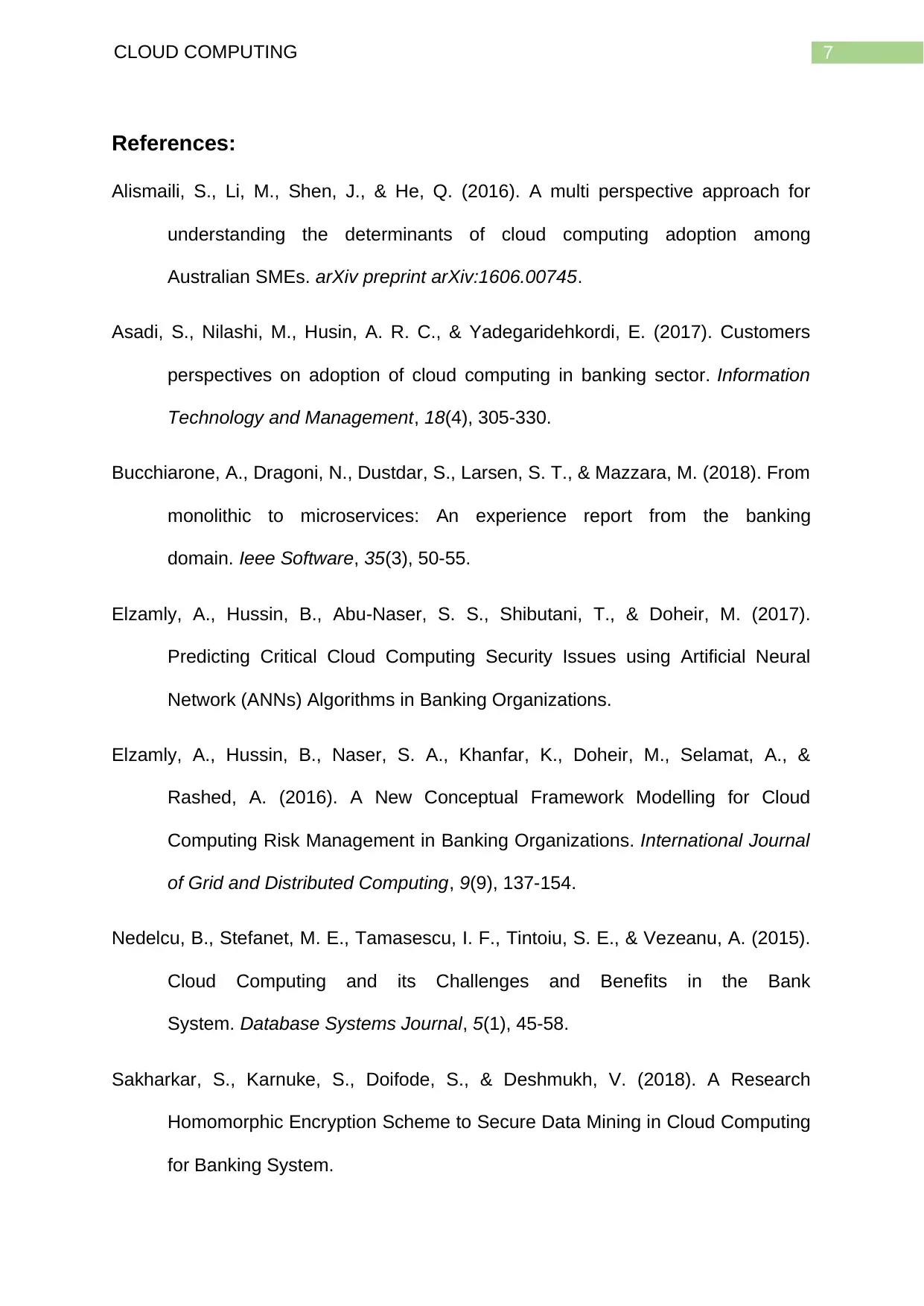
7CLOUD COMPUTING
References:
Alismaili, S., Li, M., Shen, J., & He, Q. (2016). A multi perspective approach for
understanding the determinants of cloud computing adoption among
Australian SMEs. arXiv preprint arXiv:1606.00745.
Asadi, S., Nilashi, M., Husin, A. R. C., & Yadegaridehkordi, E. (2017). Customers
perspectives on adoption of cloud computing in banking sector. Information
Technology and Management, 18(4), 305-330.
Bucchiarone, A., Dragoni, N., Dustdar, S., Larsen, S. T., & Mazzara, M. (2018). From
monolithic to microservices: An experience report from the banking
domain. Ieee Software, 35(3), 50-55.
Elzamly, A., Hussin, B., Abu-Naser, S. S., Shibutani, T., & Doheir, M. (2017).
Predicting Critical Cloud Computing Security Issues using Artificial Neural
Network (ANNs) Algorithms in Banking Organizations.
Elzamly, A., Hussin, B., Naser, S. A., Khanfar, K., Doheir, M., Selamat, A., &
Rashed, A. (2016). A New Conceptual Framework Modelling for Cloud
Computing Risk Management in Banking Organizations. International Journal
of Grid and Distributed Computing, 9(9), 137-154.
Nedelcu, B., Stefanet, M. E., Tamasescu, I. F., Tintoiu, S. E., & Vezeanu, A. (2015).
Cloud Computing and its Challenges and Benefits in the Bank
System. Database Systems Journal, 5(1), 45-58.
Sakharkar, S., Karnuke, S., Doifode, S., & Deshmukh, V. (2018). A Research
Homomorphic Encryption Scheme to Secure Data Mining in Cloud Computing
for Banking System.
References:
Alismaili, S., Li, M., Shen, J., & He, Q. (2016). A multi perspective approach for
understanding the determinants of cloud computing adoption among
Australian SMEs. arXiv preprint arXiv:1606.00745.
Asadi, S., Nilashi, M., Husin, A. R. C., & Yadegaridehkordi, E. (2017). Customers
perspectives on adoption of cloud computing in banking sector. Information
Technology and Management, 18(4), 305-330.
Bucchiarone, A., Dragoni, N., Dustdar, S., Larsen, S. T., & Mazzara, M. (2018). From
monolithic to microservices: An experience report from the banking
domain. Ieee Software, 35(3), 50-55.
Elzamly, A., Hussin, B., Abu-Naser, S. S., Shibutani, T., & Doheir, M. (2017).
Predicting Critical Cloud Computing Security Issues using Artificial Neural
Network (ANNs) Algorithms in Banking Organizations.
Elzamly, A., Hussin, B., Naser, S. A., Khanfar, K., Doheir, M., Selamat, A., &
Rashed, A. (2016). A New Conceptual Framework Modelling for Cloud
Computing Risk Management in Banking Organizations. International Journal
of Grid and Distributed Computing, 9(9), 137-154.
Nedelcu, B., Stefanet, M. E., Tamasescu, I. F., Tintoiu, S. E., & Vezeanu, A. (2015).
Cloud Computing and its Challenges and Benefits in the Bank
System. Database Systems Journal, 5(1), 45-58.
Sakharkar, S., Karnuke, S., Doifode, S., & Deshmukh, V. (2018). A Research
Homomorphic Encryption Scheme to Secure Data Mining in Cloud Computing
for Banking System.
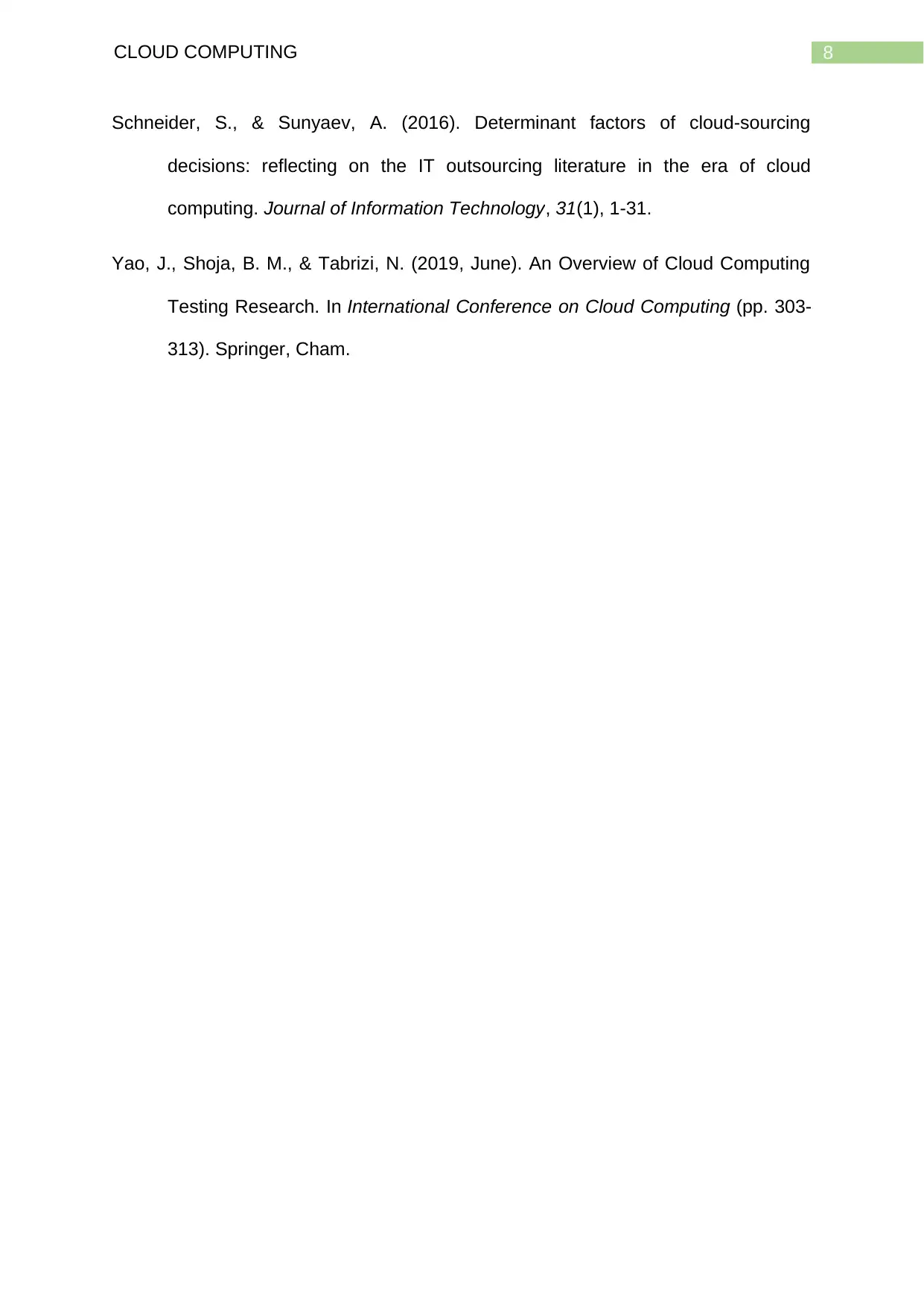
8CLOUD COMPUTING
Schneider, S., & Sunyaev, A. (2016). Determinant factors of cloud-sourcing
decisions: reflecting on the IT outsourcing literature in the era of cloud
computing. Journal of Information Technology, 31(1), 1-31.
Yao, J., Shoja, B. M., & Tabrizi, N. (2019, June). An Overview of Cloud Computing
Testing Research. In International Conference on Cloud Computing (pp. 303-
313). Springer, Cham.
Schneider, S., & Sunyaev, A. (2016). Determinant factors of cloud-sourcing
decisions: reflecting on the IT outsourcing literature in the era of cloud
computing. Journal of Information Technology, 31(1), 1-31.
Yao, J., Shoja, B. M., & Tabrizi, N. (2019, June). An Overview of Cloud Computing
Testing Research. In International Conference on Cloud Computing (pp. 303-
313). Springer, Cham.
⊘ This is a preview!⊘
Do you want full access?
Subscribe today to unlock all pages.

Trusted by 1+ million students worldwide
1 out of 9
Related Documents
Your All-in-One AI-Powered Toolkit for Academic Success.
+13062052269
info@desklib.com
Available 24*7 on WhatsApp / Email
![[object Object]](/_next/static/media/star-bottom.7253800d.svg)
Unlock your academic potential
Copyright © 2020–2025 A2Z Services. All Rights Reserved. Developed and managed by ZUCOL.




